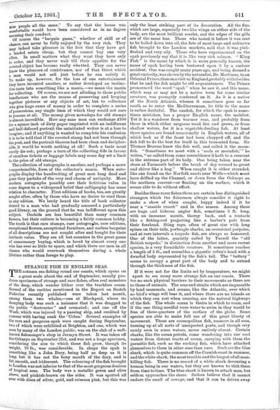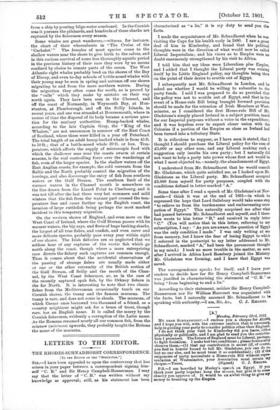STRANGE FISH IN ENGLISH SEAS.
HE autumn sea-fishing round our coasts, which opens on a great scale about the end of September, usually pro- duces specimens of strange and rare fishes, often real monsters of the deep, which wander hither over the trackless ocean. Several of the rarities mentioned in the Report on Scotch Fisheries recently published were taken last month, among them two whales,—one at Blackpool, where its decaying body was such a nuisance that it was dragged to the public " destructor " and cremated ; and one off the Wash, which was injured by a passing ship, and credited by rumour with having sunk the Cobra.' Several examples of the rare and gorgeous opah were caught during September, two of which were exhibited at Brighton, and one, which was seen by many of the London public, was on the slab of a well- known fishmonger's shop in Jermyn Street. It was taken off the Orkneys on September 21st, and was not a large specimen, considering the size to which these fish grow, though its weight, 70 lb., was considerable. In shape the opah is something like a John Dory, being half as deep as it is long, but it has not the bony mouth of the dory, and is fat, smooth, and iridescent. The colouring of the fish brought to London was not inferior to that of the most gorgeous denizen of tropical seas. The body was a metallic green and olive above, and pinkish-brown on the sides. It was spotted all over with discs of silver, gold, and crimson pink, but this was
only the least striking part of its decoration. All the fins, which are large, especially two like wings on either side of the body, are the most brilliant scarlet, and the edges of the gills are of the same hue. Those who tasted it before it was sent to be boiled down into oil, the fate of most large and unknown fish brought to the London markets, said that it was pink- fleshed and very oily. Those who have experimented on the opah previously say that it is like very rich salmon. " King Fish " is the name by which it is more generally known, the name of opah having been bestowed upon it by a curious accident. One was caught many years ago, and being deemed a great curiosity, was shown by the naturalist, Dr. Mortimer, to an Oriental Prince,then on a visit to England,probably with the idea that he and the fish might be old acquaintances. The Prince pronounced the word "opah" when he saw it, and this name, which may or may not be a native term for some similar creature, was promptly conferred on it. As it is a native of the North Atlantic, whence it sometimes goes so far south as to enter the Mediterranean, its title to the name is rather doubtful. The sunfish, for which the opah is some- times mistaken, has a proper English name, the molebut. Yet it is a wanderer from warmer seas, and probably from those in which either sargasso weed lies and grows, or from shallow waters, for it is a vegetable-feeding fish. At least three species are found occasionally in English waters, all of which look as if the front had been chopped off, and the fish left to do the best for itself in this truncated form. Sir Thomas Browne knew the fish well, and called it the moon- fish. " Sometimes we meet with a mola or moonfish,' " he writes, " so called from some resemblance it bath to a crescent in the extreme part of its body. One being taken near the shore at Yarmouth before the break of day seemed to grunt and shiver like a hog." When caught it is either stranded, like one found on the Norfolk sands near Wells—which must have drifted up the Channel, or down from the Orkneys on the northern current—or floating on the surface, which it seems able to do without effort.
Besides these rarer fishes there are certain less distinguished strangers which the fishermen always consider it right to make a show of when caught, happy indeed if it be near a "seaside resort" and in the season. Among these are huge and hideous angler fish, sometimes 5 ft. long, with an immense mouth, thorny back, and a tentacle like a fishing-rod projecting like a barber's pole from their forehead. Sting rays, often of great size with long spines on their tails, porbeagle sharks, an occasional porpoise, and at rare intervals a torpedo fish, are always so honoured. One of the latter, quaintly called by Yarrell the " old British torpedo," in distinction from another and more recent species, is a very formidable creature. It sometimes reaches a length of 5 ft., and resembles a gigantic cobra's head with a dwarfed body represented by the fish's tail. The " battery" seems to occupy a great part of the body and to extend through the thickness of the fish.
If it were not for the limits set by temperature, we might xpect to see many more strange fish on our coasts. There are no such physical barriers to their movements as there are to those of animals. The seas and straits which are impassable by land mammals, and oceans, like the Atlantic, over which no bird's wings will bear it, and where there are no islands on which they can rest when crossing, are the natural highways of the fish. The whole ocean is theirs in which to roam, and if the one thing needful were water to swim in they would be free of three-quarters of the surface of the globe. Some species are able to make full use of this great liberty of movement. These are cosmopolitan fish, roamers in all seas, turning up at all sorts of unexpected ports, and though very rarely seen in some waters, never entirely absent. Certain sharks, like the ocean petrels, come wandering into our cool waters from distant tracts of ocean, carrying with them the parasitic fish, such as the sucking fish, which have attached themselves to them in other seas than ours. Such are the blue shark, which is quite common off the Cornish coast in summer, and the white shark, the most terrible and the largest of all man- killing fish. There is no record of a white shark devouring a human being in our waters, but they are known to visit them from time to time. The blue shark is known to attack man, but seldom approaches the shore. Sailors believe that it cannot endure the smell of sewage, and that it can be driven away
from a ship by pouring bilge-water overboard. In the Cornish seas it pursues the pilchards, and hundreds of these sharks are captured by the fishermen every season.
Some whales are great wanderers,—witness, for instance, the chart of their whereabouts in "The Cruise of the ' Cachalot.' " The females of most species come to the shallow waters near the shore to give birth to the calves, and in this curious survival of some leas thoroughly aquatic period in the previous history of their race they were by no means confined by choice to remote parts of the ocean. The West Atlantic right whales probably bred on the shores of the Bay of Biscay, and even to-day schools of bottle-nosed whales with their young may be seen in spring and autumn off our shores migrating to and from the more northern waters. During the migration they often come far south, as is proved by the " calls " which they make by mistake on their way north again. They have been seen in the Channel, and off the coast of Normandy, in Weymouth Bay, at Hun- stanton, at Flamborough, and off the Scilly Islands, in recent years, and one was stranded at Bournemouth, where in course of time the disposal of its body became a serious ques- tion for the sanitary authorities. Hump-backed whales, according to the late Captain Gray, the "King of the Whalers," are not uncommon in summer off the East Coast of Scotland, where three were killed in a year off Peterhead. The total length of an adult hump-backed whale is from 45 ft. to 50 ft. ; that of a bottle-nosed whale 30 ft. or less. Tem- perature, which affects the supply of microscopic food with which the shallower seas near the coasts swarm at certain seasons, is the real controlling force over the wanderings of fish, even of the larger species. In the shallow waters off the East Anglian coasts, for example, the cold currents from the Baltic and the North probably control the migration of the herrings, and also discourage the entry of fish from southern waters or the Gulf Stream. The southern limit of the warmer waters in the Channel mouth is somewhere on the line drawn from the Lizard Point to Cherbourg, and it was not till after the last three very hot summers and mild winters that the fish from the warmer part crossed the tem- perature line and came further up the English coast, the invasion of large cuttlefish being perhaps the most marked incident in this temporary migration.
On the western shores of England, and even more on the 'West Coast of Ireland, where the Gulf Stream passes with its warmer waters, the big rays, and fleets of huge basking sharks, the largest of all true fishes, and sunfish, and even rarer and more delicate species, probably pass every year within sight of our shores. The Irish fisheries are so neglected that we seldom hear of any captures of the exotic fish which go north along the coast, though where a more enterprising race directs the fishery such captures are common enough. Thus it comes about that the accidental observations of the passing of strange fishes are usually made either at one or the other extremity of the British section of the Gulf Stream, off Scilly and the mouth of the Chan- nel, by the West Coast fishermen, or, as in the case of the recently captured opah fish, by the Orkney fishers in the far North. It is interesting to note that two classic fishes from the Mediterranean occasionally touch on our Cornish shores, the tunny and the famous muraena. The tunny is rare, and does not come in shoals. The muraena, of which Caesar once borrowed two thousand of a friend, as a country neighbour might ask for a brace of trout, though rare, has an English name. It is called the murry by the Cornish fishermen, evidently a corruption of the Latin name. As the Romans renamed nearly all our common fish, from the minnow (minims) upwards, they probably taught the Britons the name of the muraena.















































 Previous page
Previous page